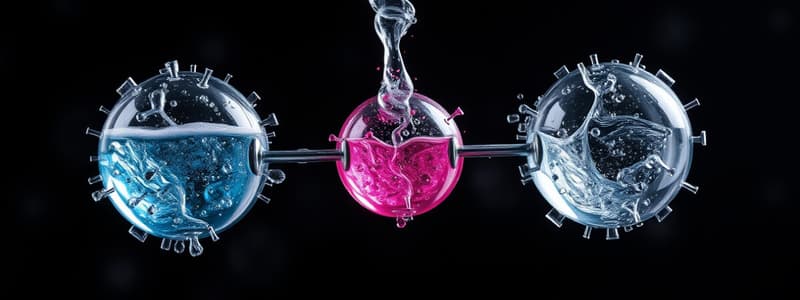Podcast
Questions and Answers
What happens under the conditions of Br2, hv?
What happens under the conditions of Br2, hv?
- A compound undergoes radical polymerization.
- An alkene undergoes anti-Markovnikov addition.
- An alkane undergoes chlorination at the least substituted position.
- An alkane undergoes bromination at the most substituted position. (correct)
Which reagent is less selective than bromination but faster?
Which reagent is less selective than bromination but faster?
- Cl2, hv (correct)
- Br2, hv
- NBS, hv
- HBr
What is the result of treating an alkene with HBr in the presence of peroxides?
What is the result of treating an alkene with HBr in the presence of peroxides?
Anti-Markovnikov addition of H and Br.
What role does NBS play in allylic bromination?
What role does NBS play in allylic bromination?
What is the order of stability for radicals?
What is the order of stability for radicals?
Halogenation at an existing chiral center leads to a racemic product.
Halogenation at an existing chiral center leads to a racemic product.
What happens during radical addition of HBr?
What happens during radical addition of HBr?
What is the purpose of radical inhibitors/scavengers?
What is the purpose of radical inhibitors/scavengers?
What characterizes radical halogenation as a synthetic technique?
What characterizes radical halogenation as a synthetic technique?
What is NBS used for?
What is NBS used for?
Study Notes
Radical Bromination
- Bromination occurs in the presence of Br2 and light (hv), favoring the most substituted position of the alkane.
Radical Chlorination
- Chlorination with Cl2 and hv is faster but less selective than bromination, making it suitable for reactions with a single regiochemical outcome.
Hydrobromination
- HBr with ROOR leads to anti-Markovnikov addition of H and Br to alkenes.
Allylic Bromination
- N-bromosuccinimide (NBS) enables bromine installation at the allylic position of alkenes, forming resonance-stabilized allylic radicals effectively.
Stability of Radicals
- Stability order of radicals mirrors carbocation trends: benzylic > allylic > tertiary > secondary > primary.
Stereochemistry of Halogenation
- Halogenation at a new chiral center results in a racemic mixture. Existing chiral centers also yield racemic products; diastereomers form if bromination occurs at these centers.
Reaction Conditions for Allylic Bromination
- NBS prevents ionic addition of bromine by maintaining low bromine concentration, acting as an alternative bromine radical source.
Radical Initiators
- Weak bond compounds like alkyl peroxides provide a source of radicals, facilitating radical reactions.
Radical Inhibitors/Scavengers
- Compounds that prevent free-radical chain reactions by forming stable radicals that do not propagate the reaction.
N-Bromosuccinimide (NBS)
- A resonance-stabilized reagent that serves as a source of bromine radicals.
Anti-Markovnikov Addition with HBr
- This process can create new chiral centers, leading to a mixture of enantiomers.
Halogenation in Synthesis
- Bromination is slower but more selective than chlorination. When starting materials have equivalent hydrogens, chlorination is feasible, while bromination is preferred to avoid product mixtures. Radical halogenation is valuable for introducing functional groups for subsequent reactions.
Studying That Suits You
Use AI to generate personalized quizzes and flashcards to suit your learning preferences.
Description
Test your knowledge on radical reactions with this set of flashcards focusing on useful reagents and reactions. Explore the differences between bromination and chlorination, including their conditions and selectivity. Perfect for students studying organic chemistry!




